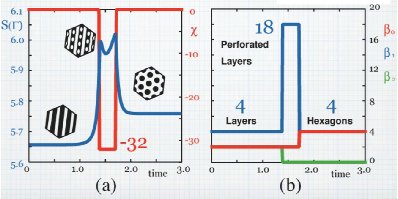Block copolymer melts and topological applications to material science

Block copolymer displays a variety of mesoscopic morphologies including hexagon, gyroid, mesh network, perfolated lamellar depending on composition ratio. In our previous papers [2,3], we investigated the geometric measures, surface area S(¡) and curvature of the level set ¡ for the three-dimensional morphologies obtained as minimizers in diblock copolymer problem and demonstrate the mechanism behind the appearance of the double gyroid morphology. Our aim in [4] and [5] is to present a new viewpoint for understanding complex dynamics, including morphology transitions, by incorporating topologically invariant quantities, the so-called homological quantities, into the field of materials science, and utilizing them as a means of observation. We measure the topology of a structure by means of its Homology, more specifically, we compute its Betti numbers and try to chracterize the transient morphologies when the system is quenched from one state to another.
Reference
[1] Nishiura, Y., and Ohnishi, I., Some mathematical aspects of the micro-phase separation in diblock copolymers, Physica D 84(1995), 31-39.
[2] Teramoto, T. and Nishiura, Y., hDouble Gyroid Morphology in a Gradient System with Nonlocal Effectsh, J. Phys. Soc. Jpn. 71 (2002), 1611-1614.
[3] Teramoto, T. and Nishiura, Y., hDouble Gyroid Morphology of Diblock Copolymer Problemh, RIMS Kokyuroku No.1356 (2004), 116-121.
[4] Teramoto, T. and Nishiura, Y.,"Morphology and dynamics of micro-phase separation" (in Japanese), Ouyo Su-uri, 15(3): 16-27 (2005)
[5] Teramoto, T., Gameiro, M. and Nishiura, Y., Applications of computational homology to 3D morphology transitions, to appear in RIMS Kokyuroku.

